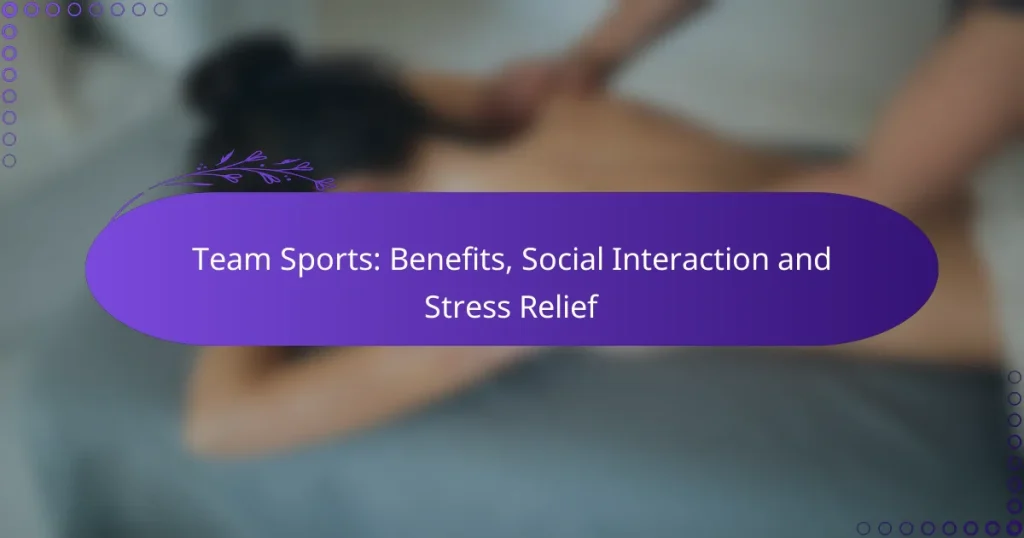Team sports offer a multitude of benefits that extend beyond physical fitness, including enhanced mental health and social interaction. By participating in these activities, individuals can improve their overall well-being, build lasting relationships, and effectively manage stress. The camaraderie and collaboration fostered in team environments create a sense of belonging that enriches personal and social lives.

How do team sports benefit physical health?
Team sports significantly enhance physical health by promoting regular exercise, which can lead to improved fitness levels and overall well-being. Engaging in these activities helps individuals maintain a healthy weight, reduces the risk of chronic diseases, and boosts mental health through social interaction.
Improved cardiovascular fitness
Participating in team sports elevates heart rate and improves cardiovascular fitness. Activities such as soccer, basketball, and rugby require continuous movement, which strengthens the heart and increases lung capacity. Regular engagement can lead to a lower resting heart rate and improved circulation.
To maximize cardiovascular benefits, aim for at least 150 minutes of moderate-intensity activity each week, as recommended by health organizations. This can be easily achieved through regular practice and games.
Increased strength and endurance
Team sports contribute to increased muscle strength and endurance through dynamic movements and resistance training. Sports like volleyball and football involve jumping, sprinting, and tackling, all of which build muscle and enhance stamina over time.
Incorporating strength training exercises, such as bodyweight workouts or resistance bands, alongside team practices can further enhance these benefits. Aim for two to three sessions per week focusing on major muscle groups for optimal results.
Enhanced coordination and agility
Team sports improve coordination and agility by requiring players to react quickly and move efficiently. Sports such as basketball and hockey involve complex movements that enhance hand-eye coordination and overall body control.
To develop these skills, practice drills that focus on quick changes of direction, footwork, and ball handling. Regular participation in team practices can lead to noticeable improvements in agility and coordination, benefiting performance in both sports and daily activities.

What are the social benefits of participating in team sports?
Participating in team sports offers significant social benefits, including the opportunity to build relationships and enhance communication skills. Engaging with teammates fosters a sense of belonging and encourages collaboration, which can lead to lasting friendships.
Building friendships and connections
Team sports create a unique environment where individuals can bond over shared goals and experiences. Regular practices and games provide consistent opportunities to interact, allowing friendships to develop naturally. These connections often extend beyond the field, leading to social gatherings and support networks.
For example, many local leagues host events or tournaments that encourage camaraderie among players. These gatherings can help strengthen relationships and create a sense of community, making participants feel more connected to their peers.
Developing teamwork and communication skills
Team sports inherently require effective teamwork and communication, which are essential skills in both personal and professional settings. Players learn to convey their thoughts clearly and listen to others, fostering a collaborative spirit. This practice can translate into improved interactions in everyday life.
Additionally, participating in team sports often involves strategizing and problem-solving as a group. This experience teaches individuals how to work together towards a common objective, enhancing their ability to navigate challenges and conflicts in various aspects of life.

How do team sports help with stress relief?
Team sports provide effective stress relief by promoting physical activity, social interaction, and a sense of belonging. Engaging in these activities helps individuals manage their stress levels through various psychological and physiological mechanisms.
Reduction of anxiety and depression
Participating in team sports can significantly reduce symptoms of anxiety and depression. The social support from teammates fosters a sense of community, which can alleviate feelings of loneliness and isolation. Regular engagement in sports can lead to improved mood and a more positive outlook on life.
Moreover, the structured environment of team sports encourages individuals to focus on the present moment, diverting attention away from stressors. This mindfulness aspect can enhance emotional resilience, making it easier to cope with daily challenges.
Increased endorphin levels
Team sports are known to boost endorphin levels, which are chemicals in the brain that act as natural painkillers and mood elevators. When engaging in physical activities, the body releases these endorphins, leading to feelings of happiness and euphoria often referred to as the “runner’s high.”
To maximize endorphin release, aim for at least 30 minutes of moderate to vigorous activity during team practices or games. Activities like soccer, basketball, or volleyball not only enhance physical fitness but also promote a sense of achievement and camaraderie, further contributing to stress relief.

What types of team sports are popular in urban areas?
In urban areas, team sports like soccer and basketball are particularly popular due to their accessibility and community engagement. These sports often feature organized leagues and tournaments that cater to various skill levels, making them appealing to a wide range of participants.
Soccer leagues
Soccer leagues in urban settings typically include recreational and competitive divisions, allowing players of all ages and skill levels to participate. Many cities have local organizations that facilitate these leagues, often running seasons that align with the warmer months.
Players usually pay a registration fee, which can range from a modest amount to higher fees for more competitive leagues. Teams often practice weekly and compete in matches on weekends, fostering a sense of community and teamwork.
Basketball tournaments
Basketball tournaments are a staple in urban areas, attracting players from diverse backgrounds. These events can be organized by local community centers, schools, or sports clubs, often featuring both amateur and semi-professional teams.
Participants typically register in advance, with entry fees varying based on the tournament’s prestige and organization. Tournaments may offer prizes or trophies, enhancing the competitive spirit and encouraging participation among local athletes.

How can you choose the right team sport for your needs?
Choosing the right team sport involves evaluating your personal interests, fitness goals, and the availability of local teams or leagues. Consider what activities excite you and how they align with your social and physical aspirations.
Assessing personal interests and goals
Start by identifying what you enjoy and what you hope to achieve through a team sport. Are you looking to improve your fitness, make new friends, or compete at a higher level? Reflecting on these questions can help narrow down your options.
For example, if you enjoy running, consider sports like soccer or basketball that incorporate running but also offer teamwork. If you prefer strategy and coordination, sports like volleyball or ultimate frisbee might be more appealing.
Considering local availability and community
Research local sports clubs, community centers, and recreational leagues to find options that fit your interests. Availability can vary significantly by region, so check for teams that welcome beginners and offer flexible schedules.
Engaging with local sports communities can enhance your experience. Look for social media groups or community boards where you can connect with others interested in the same sport, as this can lead to forming lasting friendships and a supportive environment.

What are the prerequisites for joining a team sport?
Joining a team sport typically requires a basic fitness level and a solid understanding of the sport’s rules. These prerequisites help ensure that all players can participate effectively and safely.
Basic fitness level
A basic fitness level is essential for participating in team sports, as it affects performance and reduces the risk of injury. Players should be able to engage in physical activity for extended periods, which often means having a reasonable level of cardiovascular endurance and strength.
To assess your fitness level, consider your ability to run, jump, and perform other movements relevant to the sport. Engaging in regular aerobic exercises, such as jogging or cycling, can help improve your fitness before joining a team.
Understanding of the sport’s rules
Having a clear understanding of the sport’s rules is crucial for effective participation in team sports. Familiarity with the regulations helps players make informed decisions during games and promotes fair play.
To gain a solid grasp of the rules, consider watching games, reading official rulebooks, or attending introductory workshops. Many sports organizations offer resources for beginners, which can be a valuable way to learn the ins and outs of the game.

What are the costs associated with team sports?
The costs associated with team sports can vary widely depending on factors such as the type of sport, location, and level of competition. Common expenses include registration fees, equipment, uniforms, and travel costs.
Registration fees
Registration fees are often the first cost incurred when joining a team. These fees can range from low tens of USD for recreational leagues to several hundred USD for competitive teams. It’s essential to check with the specific organization for their pricing structure.
Equipment and uniforms
Equipment and uniforms are necessary for participation in most team sports. Costs for equipment can vary significantly; for example, a basic soccer ball may cost around 20-50 USD, while specialized gear like hockey skates can exceed 200 USD. Uniforms may also be provided by the team or need to be purchased separately, typically costing between 30-100 USD.
Travel expenses
Travel expenses can add up, especially for teams participating in tournaments or leagues that require travel. Costs may include transportation, lodging, and meals. Budgeting for these expenses is crucial, as they can range from a few hundred to several thousand USD, depending on the distance and duration of the events.
Additional costs
Additional costs may include training fees, coaching expenses, and insurance. Training programs can vary, with costs ranging from 10-50 USD per session. Some teams may also require players to have personal insurance, which can add to overall expenses. Be sure to consider these factors when evaluating the total cost of participating in team sports.


